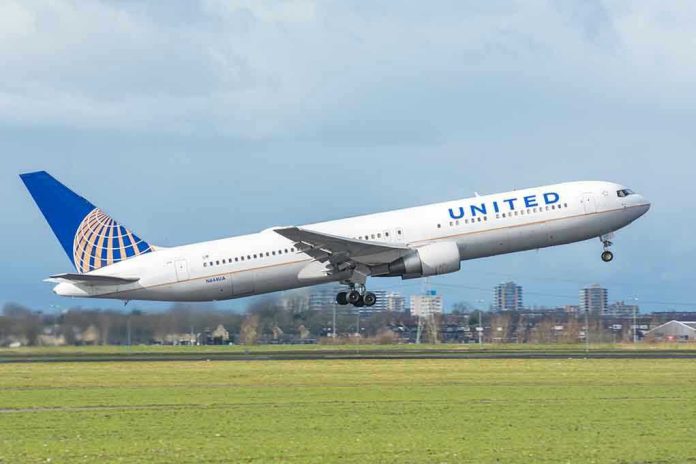
One passenger’s words on a routine United Airlines flight shattered the illusion of safety in American air travel, thrusting hundreds into a tense ordeal that reveals just how thin the line is between order and chaos at 30,000 feet.
Story Highlights
- A bomb threat aboard United flight UA380 forced an emergency landing in St. Louis, disrupting lives but causing no injuries.
- The threat, made by a passenger about his wife’s luggage, led to swift evacuation and the suspect’s arrest.
- No bomb was found, prompting renewed scrutiny of aviation security and emergency protocols.
- The incident underscores growing tension in air travel and questions about passenger behavior and airline preparedness.
A Sudden Threat Turns a Routine Flight into High-Stakes Drama
United Airlines flight UA380, a Boeing 737-700 packed with unsuspecting travelers, departed Dallas bound for Chicago on what should have been a typical Sunday morning. About 40 minutes into the flight, a chilling announcement shattered that routine: a male passenger told crew there was a bomb in his wife’s luggage. Pilots immediately declared a general emergency, rerouting the aircraft to St. Louis Lambert International Airport, one of the Midwest’s busiest hubs. As the plane touched down on runway 29, the invisible tension inside the cabin reached its peak. Passengers were evacuated and hustled to the B concourse, their nerves frayed, their plans in tatters.
Within minutes, law enforcement and bomb squads fanned out, scouring the plane for any sign of explosives. The 26-year-old man at the center of the chaos was arrested on the spot. Authorities conducted a meticulous search, finding no bomb, but the psychological shockwave rippled through everyone involved. While no one was physically harmed, the incident ignited a new wave of anxiety about the security of domestic flights and the unpredictable nature of human behavior in confined, high-stress environments.
Emergency Response Puts Security Protocols under the Microscope
Lambert St. Louis International Airport’s emergency response played out with military precision, a testament to protocols honed since the early 2000s. Airport Director Rhonda Hamm-Niebruegge publicly praised the seamless cooperation between airport staff, law enforcement, and United Airlines. Flights resumed after a temporary shutdown, but the aftermath left more than logistical headaches; it triggered a fresh round of debate over how airlines and airports handle in-flight threats, the adequacy of passenger screening, and the balance between public safety and personal liberties.
United Airlines, facing media scrutiny and concerned passengers, issued brief statements but withheld detailed commentary pending further investigation. The airline’s reputation—built on reliability and safety—now faces a familiar but unwelcome test: how quickly can it restore confidence after a high-profile disruption, even when no physical threat materialized?
Behind Every Panic: The Real Cost of Threats and Hoaxes
While bomb threats on commercial flights remain rare, their impact is anything but minor. For travelers on UA380, the disruption was immediate and personal: lost time, ruined plans, and a sense that the skies are not as safe as they once seemed. For the airline and airport, the costs included delayed schedules, mobilized emergency resources, and the heavy burden of public scrutiny. For law enforcement, each incident is a reminder that even a false alarm demands total commitment—every threat must be treated as real until proven otherwise.
United flight forced to make emergency landing in St Louis after passenger made bomb threat, report says | The Independent https://t.co/RtJBITyoV0
— FireandAviation TV (@FireandAviation) November 17, 2025
This episode also casts a spotlight on a troubling trend: a rise in disruptive passenger behavior since the pandemic, with incidents ranging from in-flight altercations to threats that force entire airports into lockdown. Experts debate whether stricter pre-boarding screening or enhanced mental health assessments are the answer, but all agree that the psychological toll of these scares is real and lasting. Passengers and crew now fly with heightened awareness, knowing that one person’s reckless words can upend hundreds of lives in an instant.
Repercussions for Aviation Security and the Public’s Peace of Mind
The fallout from the UA380 bomb threat will ripple through policy discussions long after the plane is cleared for its next flight. Federal authorities and aviation executives are already reviewing protocols, seeking ways to close the gap between perceived and actual security. Law enforcement continues to investigate the suspect’s motives, aware that intent can be as important as outcome in an age of heightened vigilance.
For the wider public, the incident is a wake-up call. The balance between convenience and safety grows ever more delicate, and the expectation that air travel is routine gets challenged each time the emergency slides deploy. As the headlines fade, airlines and airports must answer tough questions about preparedness and prevention. For the passengers of UA380, the lesson is visceral: in the air, safety is never just about metal detectors and baggage checks—it’s about trust, vigilance, and the unpredictable nature of people themselves.










